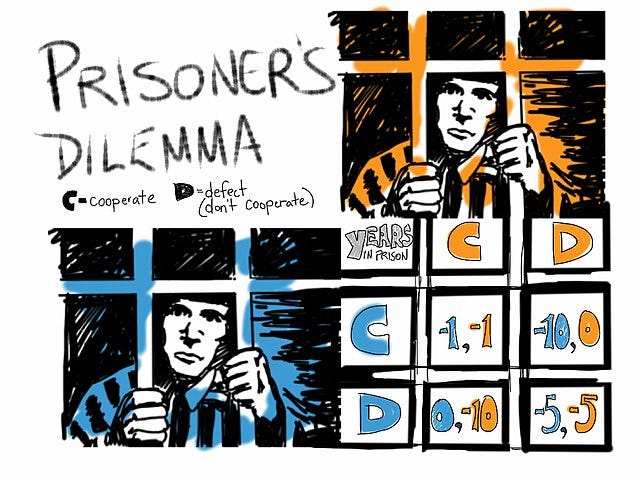Understanding the Impact of the Prisoner's Dilemma on Choices
Written on
Chapter 1: The Essence of the Dilemma
Each day, we encounter decisions that force us to choose between pursuing our own interests or collaborating with others in society. The challenge lies in identifying the best course of action—one that minimizes risks while optimizing outcomes. This often means settling for results that may not be the absolute best, but rather the most favorable when considering potential risks.
In many scenarios, the game is continuous or at least extends as long as human interactions persist. This complexity arises because, ultimately, individuals are not merely playing for short-term victories, but for long-term outcomes.
In the realm of Game Theory, this intricate choice is termed the "prisoner’s dilemma." This concept is incredibly adaptable and can be applied to various aspects of communal life, providing insightful reflections on our interpersonal dynamics in different settings.
Indeed, the prisoner’s dilemma encapsulates a range of situations—from modern conflicts to viral outbreaks, reckless driving on a Saturday night, or interpersonal relationships. It serves as a "rational" cornerstone for resolving dilemmas, although it often conceals a degree of "irrationality."
Let’s consider an example: John boards a tram during peak hours, blending into the throng of passengers. He possesses a ticket, the last one in his booklet, but chooses not to validate it, telling himself, “I’ll do it only if I see the inspectors.” Meanwhile, he spots Mary, who boards at the same stop, validating her ticket without hesitation. John's guilt begins to rise, yet he continues his unfair behavior.
After several stops, they both find themselves at the exit, with no inspectors in sight. John saves his ticket while Mary validates hers—an action that seems pointless. If everyone adopted John's mindset, however, public transport would rapidly suffer financial losses, leading to widespread fare evasion.
John faces a version of the "prisoner’s dilemma": Should he "betray" other passengers by failing to validate his ticket, or "cooperate" by contributing to the system and adhering to the rules?
This dilemma is indeed thought-provoking. Let's delve deeper...
Section 1.1: What is the Prisoner's Dilemma?
The prisoner’s dilemma stands as a quintessential illustration within Game Theory, a mathematical discipline focused on decision-making in social interactions and the strategies employed to maximize benefits.
Developed in 1950 by RAND Corporation mathematicians Merrill Flood and Melvin Dresher, and later formalized by Albert William Tucker, the dilemma is categorized under "non-cooperative games." Unlike "cooperative games," these do not allow for prior agreements or collaborative strategies among players.

The dilemma presents the following scenario:
Two suspects, A and B, are apprehended by law enforcement. Lacking sufficient evidence, the police interrogate both individuals separately, offering them these options: If one confesses while the other remains silent, the silent one faces 10 years in prison while the confessor goes free. If both stay silent, they each receive a one-year sentence; if both confess, they each serve five years. Importantly, neither suspect knows what the other has chosen.
From a purely self-interested viewpoint, confessing appears to be the optimal choice for both: at best, they serve no time, and at worst, five years. This choice is known as the "dominant strategy," as it benefits each suspect regardless of the other's decision.
However, this leads to complications.
Subsection 1.1.1: The Paradox of the Dilemma
The mutual betrayal, as described, seems the least risky. It also leads to what is termed "Nash equilibrium," named after mathematician and Nobel laureate John Nash, who significantly advanced Game Theory.
According to the Nash equilibrium, both prisoners would choose rationally, benefiting their immediate social environment since it would yield a favorable outcome for both. Yet, this creates a paradox: while confessing is the least risky individual choice, collectively, remaining silent would yield the minimal sentence (1 year versus 5 or even 10 years) and foster a sense of solidarity.
Unfortunately, such cooperation is virtually unattainable. Even if both prisoners agree to stay silent, there’s no guarantee the other will uphold the pact, compelling one to betray the other for personal freedom.